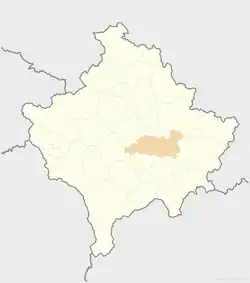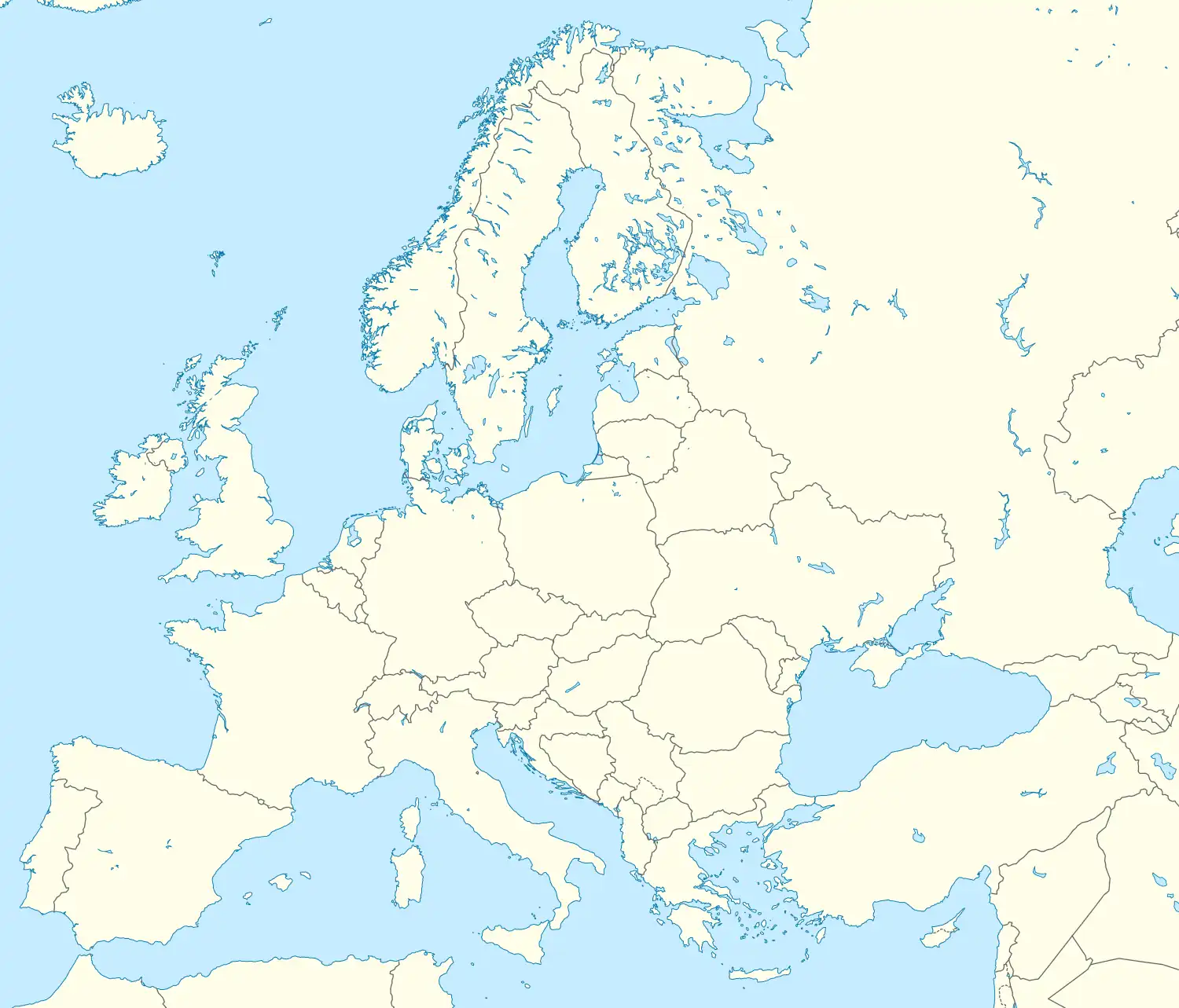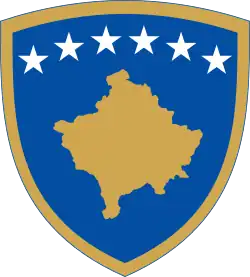Lipjan
Lipjan (definite form: Lipjani) or Lipljan (Serbian Cyrillic: Липљан) is a town and municipality located in the Pristina District of Kosovo. According to the 2011 census, the town of Lipjan has 6,870 inhabitants, while the municipality has 57,605 inhabitants.
Lipjan | |
|---|---|
Town and municipality | |
 Flag  Emblem | |
 Lipjan  Lipjan | |
| Coordinates: 42°32′N 21°06′E | |
| Country | Kosovo |
| District | District of Pristina |
| Government | |
| • Mayor | Imri Ahmeti (LDK) |
| • Municipal | 338 km2 (131 sq mi) |
| Elevation | 563 m (1,847 ft) |
| Population (2011) | |
| • Urban | 6,870 |
| • Municipal | 57,605 |
| • Municipal density | 170/km2 (440/sq mi) |
| Time zone | UTC+1 (CET) |
| • Summer (DST) | UTC+2 (CEST) |
| Postal code | 14000 |
| Area code | +383 38 |
| Car plates | 01 |
| Website | kk |
Name
The town's name derives from Ulpiana,[1][2] the Dardanian and Roman era settlement that preceded Lipjan, possibly due to either a Ul- to Li- shift seen elsewhere in Roman toponyms.[3] Selami Pulaha states that the shift from Ulpiana to Lipjan is in accordance with early Albanian phonetic rules, and must therefore have been inhabited by Albanians to reach its current form.[4] The same theory is supported by Noel Malcolm and van Wijk.[5]
The Roman city of Ulpiana was located near Lipjan and it was named in honor of the Roman Emperor Marcus Ulpius Nerva Traianus. In the early Middle Ages it was part of the Bulgarian Empire and a diocese of the Bulgarian Patriarchate. The neo-Latin form Lypenion for the city occurs for the first time in a Byzantine text from 1018 AD that confirmed the town as an episcopal seat of the Bulgarian Archbishopric of Ohrid following the Byzantine conquest of Bulgaria in the same year.[6]
Geography
Lipjan is located in the central part of the Republic of Kosovo and at the crossroads of the most important roads in the region. The town is located south of Pristina at a distance of around 17 km (11 mi). The Municipality of Lipjan contains 422 km2 (163 sq mi) of land, and it consists of 70 villages. It borders the municipalities of Drenas, Kosovo Polje and Pristina to the north, Malisheva to the west, Novo Brdo and Gjilan to the east and Ferizaj, Suva Reka and Shtime to the south.[7]
History
Early Period
The ancient predecessor of Lipjan, Ulpiana, was an important city in the Illyrian and Dardanian spheres. By the 2nd century CE, it was the economic, political and culture centre of the province of Dardania.[8] It was situated on a road between ancient Naissus and Lissus, called Via de Zenta. It suffered from barbarian raids, especially the incursion of 517CE, and from a great earthquake that damaged much of Dardania. By the time Justinian I began his restoration of the Byzantine Empire, Ulpiana was in a ruinous condition - after repairing the town, Justinian labelled it Justiniana Secunda. Ulpiana also played an important ecclesiastical role, having had a local bishop present at the Council of Serdica in 347CE and at the Ecumenic Synod of 553CE. Florus and Laurus were said to have settled in Ulpiana. The old Byzantine church in Lipjan serves as a reminder of the ecclesiastical importance the area once held - it continued to hold a bishopric seat in the Bulgarian empire and once again in the Byzantine empire once the region was recaptured.[9]
Middle Ages
Lipjan is the birthplace of the Albanian noble, Lekë Dukagjini,[10] who was born here in 1410. He was a close friend of the Albanian military commander and ruler, Gjergj Kastrioti Skanderbeg, and a participant in the Albanian League of Lezhë. He was a member of the Dukagjini family, whose principality extended from Northern Albania to modern-day Kosovo.[11][12]
Kosovo War
Lipjan was the sight of war crimes during the Kosovo War. Ethnic Albanians were forced out of the area on April 20 by Serb forces, and Albanian residences were looted and burned by said forces. Serbian paramilitary forces were alleged to have shot more than 50 civilians in 3 surrounding villages.[13]
Demographics
| Year | Pop. | ±% p.a. |
|---|---|---|
| 1948 | 29,700 | — |
| 1953 | 33,132 | +2.21% |
| 1961 | 38,573 | +1.92% |
| 1971 | 47,526 | +2.11% |
| 1981 | 57,705 | +1.96% |
| 1991 | 69,451 | +1.87% |
| 2011 | 57,605 | −0.93% |
| 2016 est. | 56,643 | −0.34% |
| Source: Division of Kosovo | ||
About 57,605 people live in the municipality of Lipjan, and of those about 6,870 people live in the town of Lipjan, while the rest live in rural areas (villages).[14]
Most of the population are Albanians (89%) and other nationalities consist of Serbs (6%), Croats (1%), Roma (1%) and 2.9% others. The age of the population is young, of which about 40% are aged 0-14 years, 45% are aged 15-65 years and 15% are aged over 65 years. The average family size is five members.[14]
Municipality
- Akllap/Oklap
- Babush i Muhaxherëve/Muhadžer Babuš
- Baicë/Banjica
- Banullë/Bandulić
- Breg i Zi/Crni Breg
- Brus
- Bujan/Bujance
- Bukovicë/Bukovica
- Divlakë/Divljaka
- Dobrajë e Madhe/Velika Dobranja
- Dobrajë e Vogël/Mala Dobranja
- Gadime e Epërme/Gornje Gadimlje
- Gadime e Ulët/Donje Gadimlje
- Gllanicë/Glanica
- Gllavicë/Glavica
- Gllogoc/Glogovce
- Grackë e Vjetër/Staro Gracko
- Grackë e Vogël/Malo Gracko
- Gumnasellë/Guvno Selo
- Hallaç i Madh/Veliki Alaš
- Hallaç i Vogël/Mali Alaš
- Hanroc/Androvac
- Janjevo/Janjevë
- Kleçkë/Klečka
- Kojskë/Konjsko
- Konjuh
- Kraishtë/Krajište
- Krojmir/Krajmirovce
- Leletiq/Laletić
- Lipovica
- Livađe/Livagjë
- Llugaxhi/Lugadžija
- Llugë/Lug
- Magura
- Marec/Marevce
- Medvec/Medvece
- Mirenë/Mirena
- Okosnicë/Okosnica
- Plitkoviq/Plitković
- Poturoc/Poturovce
- Qellapek/Čelopek
- Qyqylagë/Čučuljaga
- Resinoc/Rusinovce
- Ribar i Madh/Veliko Ribare
- Ribar i Vogël/Malo Ribare
- Ruboc/Rabovce
- Rufc i Ri/Novo Rujce
- Rufc i Vjetër/Staro Rujce
- Shalë/Sedlare
- Shisharkë/Šišarka
- Sllovi/Slovinje
- Smallushë/Smoluša
- Teqë/Teća
- Topličane
- Torina/Torinë
- Trbovce/Tërbuc
- Varigoc/Varigovce
- Vërshec/Vrševce
- Vogaçicë/Vogačica
- Vrelo
- Vrellë e Goleshit/Goleško Vrelo
- Zlokućane
See also
References
- Illyés, Elemér (1988). Ethnic Continuity in the Carpatho-Danubian Area. East European Monographs. p. 172. ISBN 9780880331463.
- Du Nay, André (1977). The Early History of the Rumanian Language. Jupiter Press. p. 17. ISBN 9780933104037.
- Lafe, Emil (1976). "Toponymes latino-romans sur le territoire de l'albanais". Iliria. Page 116
- Pulaha, Selami (1984). Popullsia shqiptare e Kosovës gjatë shek: studime dhe dokumente. XV-XVI. 8 Nëntori. p. 11.
- Origins, Serbs, Albanians and Vlachs - Noel Malcolm
- Collective (1965). Greek Sources about Bulgarian History (GIBI), volume VI (in Bulgarian and Greek). Sofia: Bulgarian Academy of Sciences Press. p. 44.
- Elsie, Robert (15 Nov 2010). Historical Dictionary of Kosovo. Scarecrow Press. p. 178. ISBN 9780810874831.
- Warrander, Gail; Knaus, Verena (2010). Kosovo: The Bradt Travel Guide. Bradt Travel Guides. p. 139. ISBN 9781841623313.
- Evans, John (1885). "Antiquarian Researches in Illyricum". Archaeologia, or, Miscellaneous Tracts, Relating to Antiquity. 49 (1): 62–64.
- Nogueira, Adeilson (31 Mar 2018). Moedas De Kosovo. Clube de Autores. p. 16.
- Sellers, Mortimer; Tomaszewski, Tadeusz (23 July 2010). The Rule of Law in Comparative Perspective. ISBN 9789048137497.
- Warrander, Gail; Knaus, Verena (2007). Kosovo. ISBN 9781841621999.
- Erasing History: Ethnic Cleansing in Kosovo. Department of State. 1999. p. 18. ISBN 9780160500657.
- "Plani Zhvillimor Komunal i Lipjanit 2013-2023+" (PDF).



